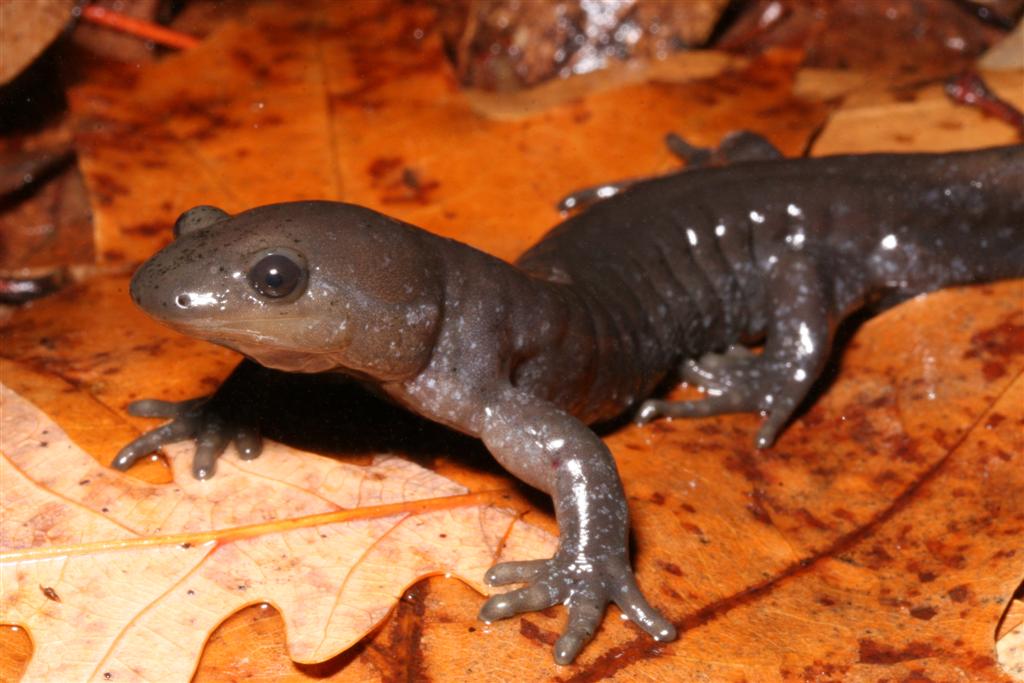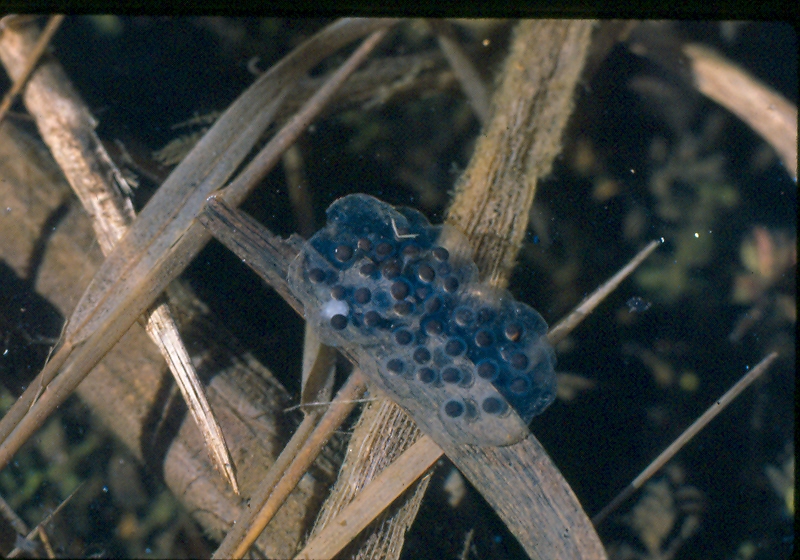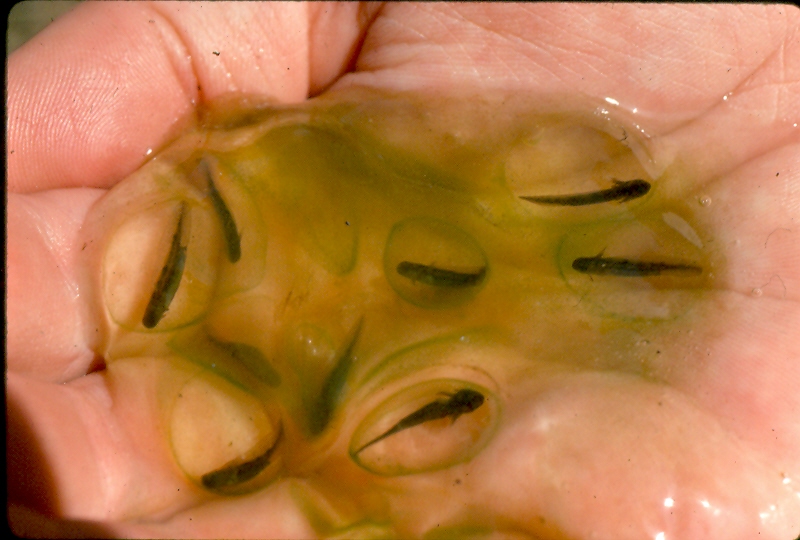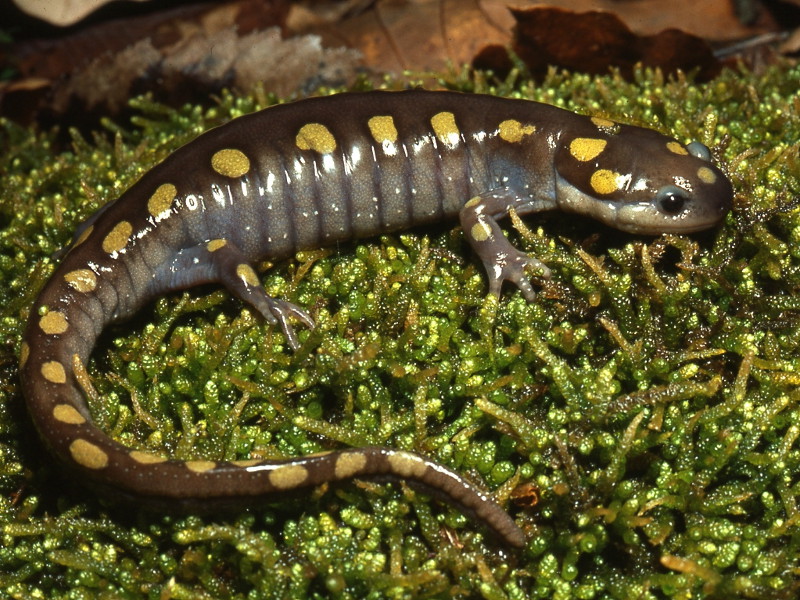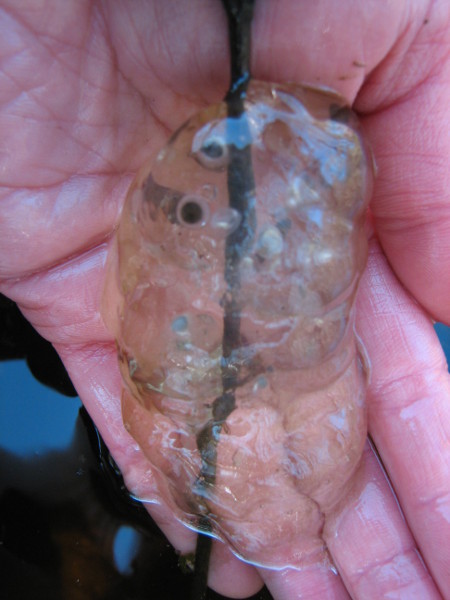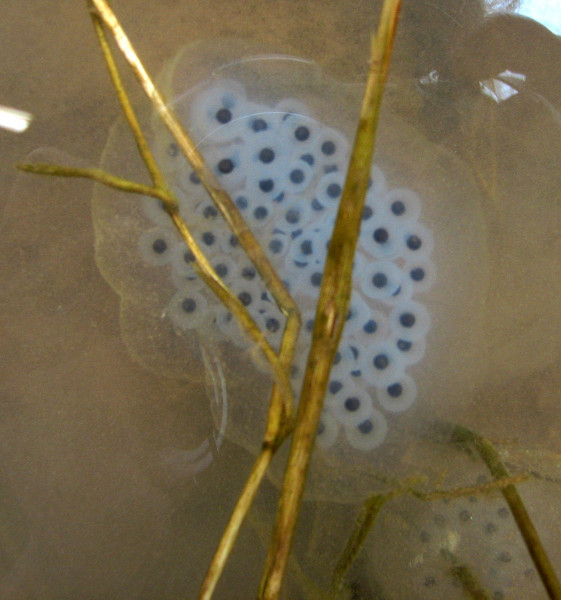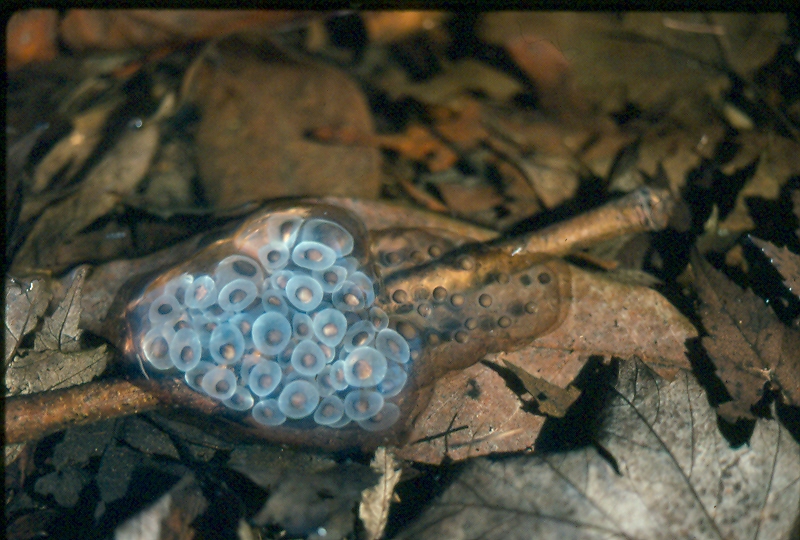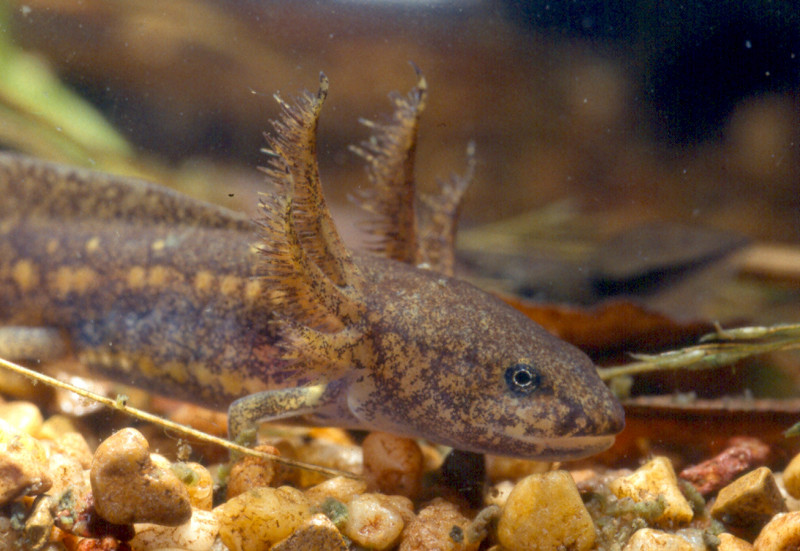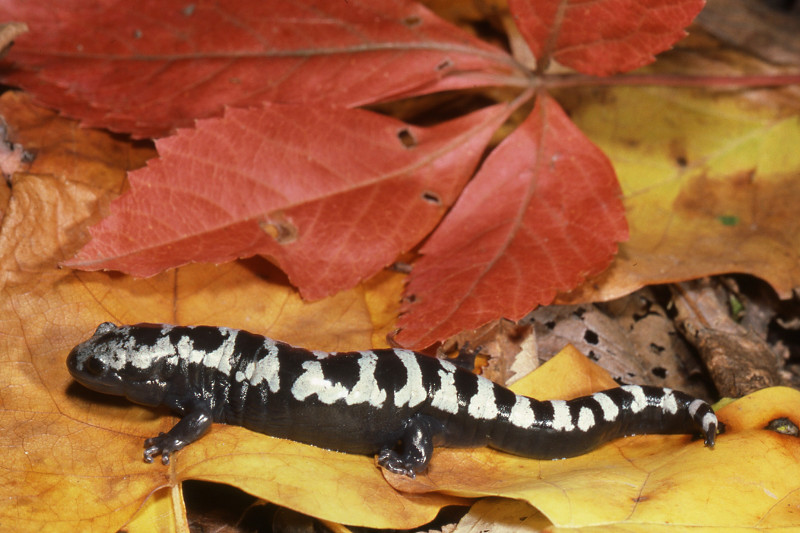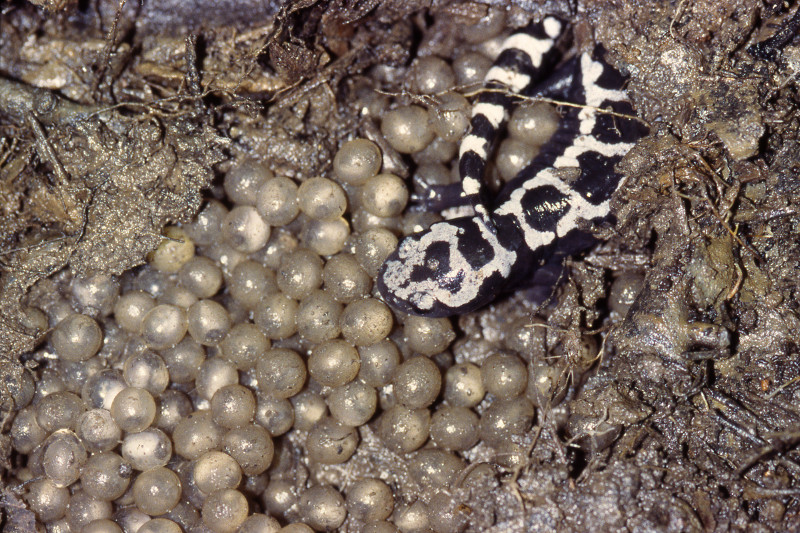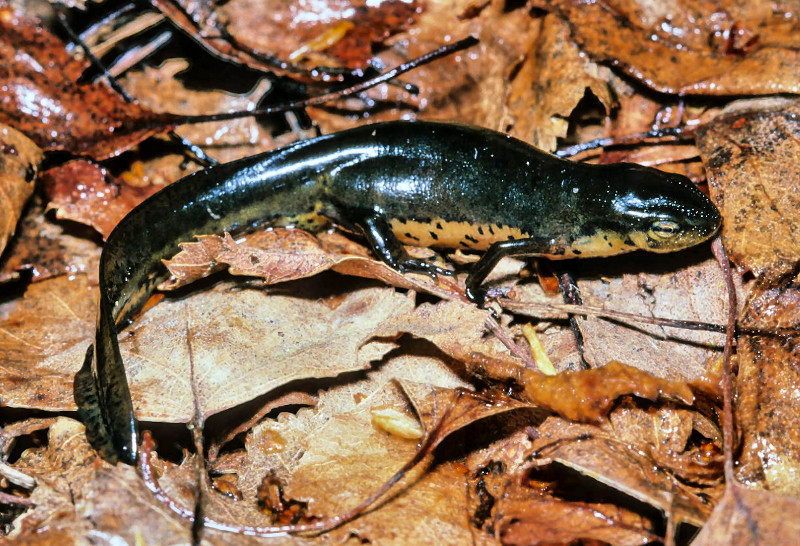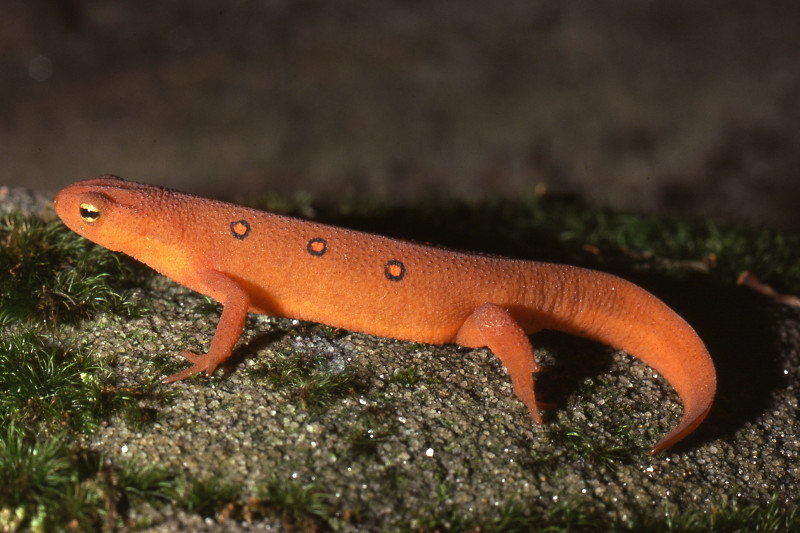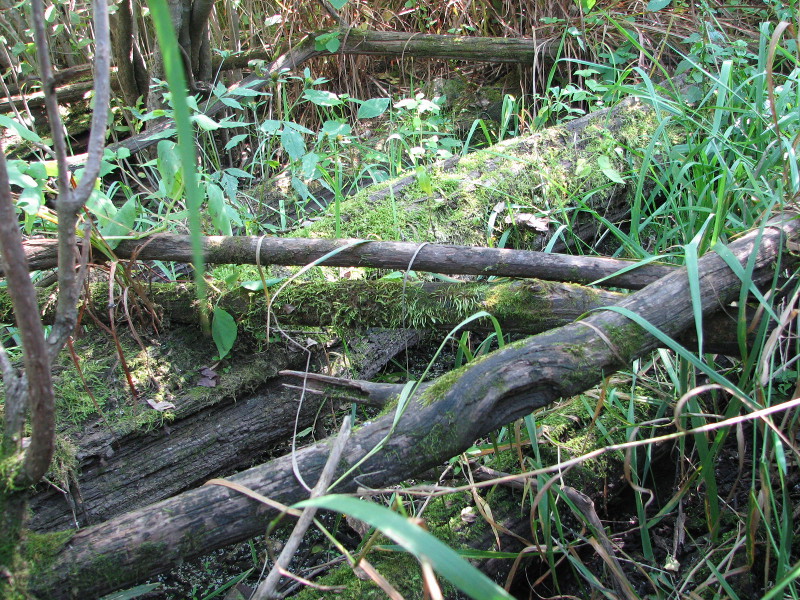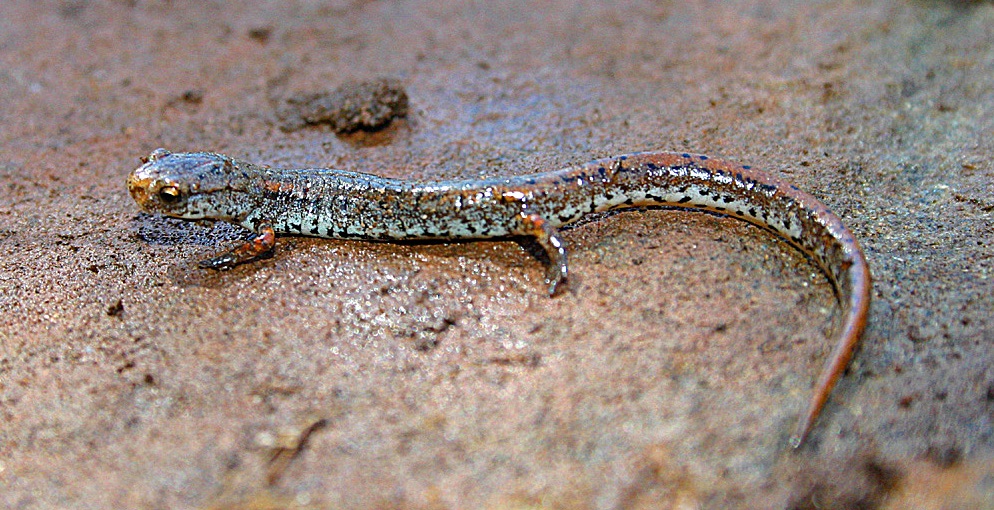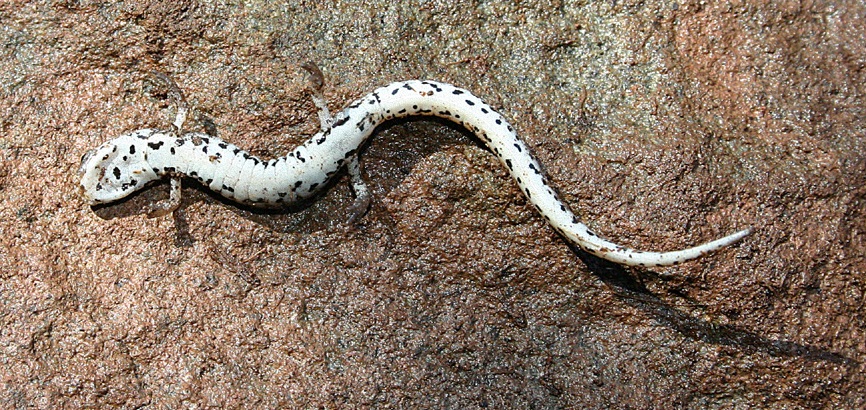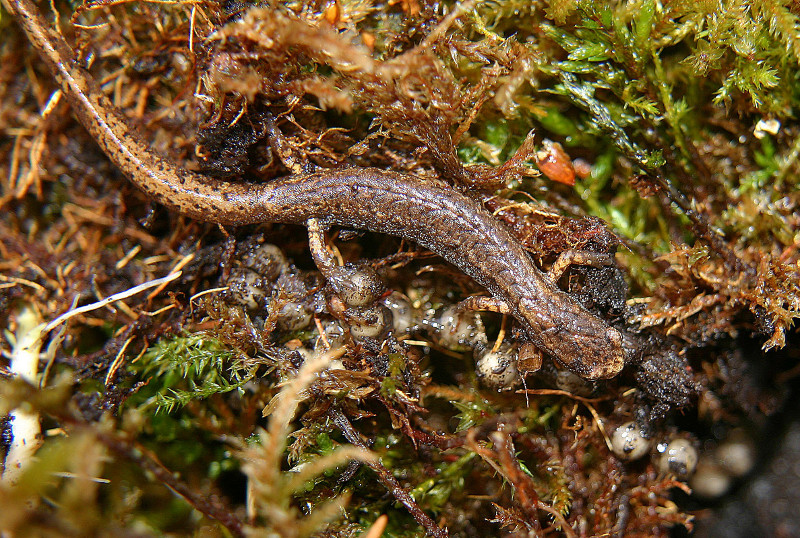 Vernal Pool Salamanders
Vernal Pool Salamanders
Mole Salamanders
Animals that depend upon vernal pools for reproduction and development of their young are called vernal pool indicator (or obligate) species. Pennsylvania's large and secretive mole salamanders are all vernal pool indicators, along with two other frogs and several species of small freshwater crustaceans.
Three species of mole salamanders are found in Pennsylvania: the Jefferson salamander (Ambystoma jeffersonianum), the spotted salamander (Ambystoma maculatum), and the marbled salamander (Ambystoma opacum). A fourth species, the blue-spotted salamander (Ambystoma laterale), looks very similar to the Jefferson salamander but has only been reported from a few sites in Pennsylvania.
The mole salamanders spend the majority of the year feeding in subterranean tunnels in the woodlands that surround seasonal pools. Their diet consists of snails, worms, insect larvae, spiders, isopods, crickets, and other small animals they encounter. This underground lifestyle makes them difficult to find during most of the year. But once a year, they emerge to the surface and migrate to seasonal pools where males and females find each other, court, breed, and lay eggs.
The time for egg and larval development varies by species and by local environmental conditions. As young salamanders (larvae), mole salamanders are aquatic and breathe through gills. As adults, they become terrestrial and breathe with lungs.
Jefferson Salamander (Ambystoma jeffersonianum) - INDICATOR
Adult Jefferson salamanders are slate gray or brownish with pale blue flecking that is heaviest
on their sides. They average 4 to 7 inches in length; males are smaller than females (Conant
and Collins, 1998). Jefferson salamanders move to seasonal pools to breed very early in the
spring; movements even occur when snow and ice cover the ground.
Jefferson salamanders usually lay their eggs between March and early April. The female lays a series of small egg masses each attached to vegetation or branches in the pool. These egg masses tend to be smaller and less firm than those of the spotted salamander. They are also more slender and cylindrical than the rotund spotted salamander egg masses. Jefferson egg masses are clear and hard to see in the water although they often turn a greenish color from algae. The eggs develop for a period of thirty to forty-five days and hatch in April and May. The larvae grow for three to four months and transform into immature terrestrial adults from July through August (Hulse et al. 2001).
This species is less common than the other mole salamanders. Generally, Jefferson salamanders seem to prefer upland deciduous and mixed hardwood-coniferous forests that support seasonal pools (Hulse et al. 2001). More information is needed on the distribution and habitat needs of this species.
NOTE: The blue-spotted salamander (Ambystoma laterale) also occurs in Pennsylvania and is very similar in appearance to the Jefferson salamander. This species was previously known from New York but was not confirmed in Pennsylvania until 2000. It is known from only a few locations in McKean, Northampton, and Warren Counties and is listed as Endangered in Pennsylvania. For an excellent article on this rare salamander and the discovery of some very unusual populations, see the May/June 2012 issue of Pennsylvania Angler and Boater.
Spotted Salamander (Ambystoma maculatum) - INDICATOR
The spotted salamander is the most common mole salamander in Pennsylvania. Adult spotted
salamanders have bright yellow spots on a dark black to bluish -black background. They
average 7 inches in length with no difference in body length between males and females
(Hulse et al. 2001). Spotted salamanders move to seasonal pools to breed early in the spring,
though they usually move later than the Jefferson salamanders.
Spotted salamanders generally lay their eggs between mid-March and mid-April. The small, firm egg masses often contain 100 or more eggs in a cluster (Shaffer 1991). The eggs are attached to vegetation in the pool or rest on the bottom. Egg masses may be clear or milky-white, and over time often develop a greenish color from algae. Spotted salamander egg masses tend to be more rotund in shape than Jefferson egg masses, which are more slender and cylindrical. The eggs develop for a period of thirty to fifty days and hatch from mid-May to June. The larvae transform into immature terrestrial adults from August through September (Hulse et al. 2001).
Spotted salamanders are found in upland or lowland deciduous forests or mixed hardwood-coniferous forests that support seasonal pools. They prefer shallow pools with emergent vegetation where they can attach their egg masses, and pools with thick leaf litter on the bottom where the larvae can hide (Hulse et al. 2001).
Marbled Salamander (Ambystoma opacum) - INDICATOR
Adult marbled salamanders are black with silver or white bands across the body.
There is much variety in the appearance of the bands, but they are often expanded
at the ends. Marbled salamanders are stocky and shorter on average than the other
mole salamanders. The average length for males and females is around four inches;
females are slightly larger than males (Hulse et al. 2001).
The marbled salamander differs from the Jefferson and spotted salamanders in its reproductive cycle. Adult marbled salamanders migrate to seasonal pools to court and mate in early fall rather than in the spring. The female lays eggs sometime between September and November, depending mostly on local temperatures. She constructs a nest for her clutch of 48-200 eggs in the autumnal pool basin under leaves, logs, or rocks (Hulse et al. 2001). She usually stays at the nest protecting the eggs, until the pool begins to fill with water from rainfall or snowmelt.
The embryos hatch soon after the nest is inundated with the rising waters of the seasonal pool. The marbled salamander larvae gain a size advantage by feeding and growing for several months before the Jefferson and spotted salamanders hatch later in the spring. Marbled salamander larvae are also the first of the mole salamanders to complete their larval development, a process that takes about four and a half months from hatching to transformation into immature terrestrial adults that leave the pool (Hulse et al. 2001). More information is needed on the distribution and habitat needs of this species. In general, marbled salamanders utilize seasonal pools in upland forests that flood during the winter and spring.
Newts (Salamandridae)
Red-spotted Newt (Notophthalmus viridescens) - FACULATIVE
The red-spotted newt is found throughout the
state in upland areas. They utilize both temporary and permanent bodies of water to complete their life
cycle. Adult body lengths vary from 2 to 4 13/16 inches (Conant and Collins 1998). Newts have a
more complex life cycle than other salamanders because there is a distinct sub-adult stage.
Eggs are deposited in still water.
The larvae develop and approximately three months later leave the water as immature terrestrial adults (Hulse et al. 2001). This 'red eft' stage (shown in the picture below) lasts for several years. Once they become sexually mature, they return to the water and live an aquatic life. The photos show the dramatic difference in coloration between the red eft stage and the aquatic adult. The red eft has granular orange-red skin; adult newts have smooth olive green skin. Both the eft and adult stages have red dots outlined in black on the back and tail.
Lungless Salamanders (Plethodontidae)
Four-toed Salamander (Hemidactylium scutatum) - FACULATIVE
This small salamander measures only 2 3/8 to
2 7/8 inches in total length. Males have a shorter body than females (Hulse et al. 2001). They are named four-toed
because both front and hind feet have four toes; other salamanders have five toes on the hind feet. The four-toed
salamander has a reddish-brown back with black mottling. The ventral surface has irregular black blotches that stand
out against a white underside. They are strongly associated with sphagnum moss and are found in forested areas that
have bogs, marshes, or woodland pools. Females nest in moss that overhangs or is near the edge of standing water.
The eggs hatch and enter the water to go through an aquatic larval stage.

.jpg)
